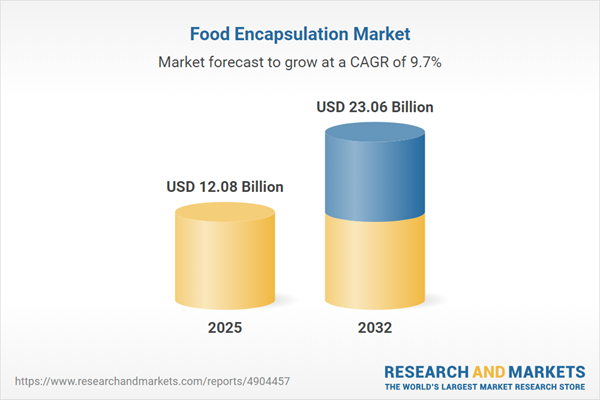Speak directly to the analyst to clarify any post sales queries you may have.
Food encapsulation is quickly establishing itself as a core enabler for ingredient stability and functional food innovation. As manufacturers seek advanced solutions for shelf life, sensory masking, and targeted nutrient delivery, the food encapsulation market is primed for strategic transformation across global supply chains and consumer segments.
Market Snapshot: Food Encapsulation Market Size, Growth Rate, and Projections
The food encapsulation market grew from USD 10.99 billion in 2024 to USD 12.08 billion in 2025. It is expected to maintain robust momentum at a CAGR of 9.70%, ultimately reaching USD 23.06 billion by 2032. The market’s dynamic growth reflects increasing adoption of encapsulation techniques across applications, demand for enhanced product functionality, and continued advancements in encapsulation technology.
Scope & Segmentation: Breadth of Technology, Ingredient, and Global Reach
- Encapsulation Techniques: Coacervation, Extrusion, Freeze Drying, Liposome Entrapment, Molecular Inclusion, Spray Drying, including both complex and simple processes.
- Core Ingredients: Colorants, Enzymes, Essential Oils, Flavors, Probiotics, Vitamins (Vitamin B Complex, Vitamin C, Vitamin D).
- Wall Ingredient Types: Carbohydrates (Gum Arabic, Maltodextrin), Gums, Lipids, Proteins (Gelatin, Whey Protein).
- Application Segments: Bakery (bread, cakes, pastries, cookies), Beverages, Confectionery, Dairy (cheese, yogurt), Meat Products, Sauces and Dressings.
- Geographic Coverage: Americas (United States, Canada, Mexico, Brazil, Argentina, Chile, Colombia, Peru), Europe Middle East & Africa (United Kingdom, Germany, France, Russia, Italy, Spain, Netherlands, Sweden, Poland, Switzerland, United Arab Emirates, Saudi Arabia, Qatar, Turkey, Israel, South Africa, Nigeria, Egypt, Kenya), Asia-Pacific (China, India, Japan, Australia, South Korea, Indonesia, Thailand, Malaysia, Singapore, Taiwan).
- Leading Companies Profiled: Advanced Bionutrition Corp., ALFA LAVAL Corporate AB, AnaBio Technologies, Archer-Daniels-Midland Company, Ashland Inc., Balchem Inc., BASF SE, Calyxia S.A.S., Cargill Inc., Coating Place, Inc., DuPont de Nemours, Inc., Encapsys, LLC, Ingredion Incorporated, INNOV'IA, International Flavors & Fragrances, Inc., Kerry Group plc, Koninkliike DSM N.V., Lycored Corp., Mandar Food Products, Maxx Performance Inc., MikroCans d.o.o., Sunson Industry Group Co., Ltd., Symrise AG, TesteTech Ltd, Vitablend Netherland BV, Glatt Ingenieurtechnik GmbH, Sensient Colors LLC, Firmenich SA, Ronald T. Dodge Company, Blue California, Inc., Givaudan International SA.
Key Takeaways for Senior Decision-Makers
- The convergence of advanced materials science and process engineering is driving integration of encapsulation solutions into mainstream food and beverage offerings.
- Consumer-led preferences, such as clean labels, natural ingredients, and personalized nutrition, are redefining product development pipelines and stimulating technology adoption in encapsulation.
- Manufacturers are prioritizing R&D partnerships and investment in new carrier matrices, particularly biopolymers and lipid vesicles, enabling differentiation in functional and fortified food categories.
- Shift toward sustainable sourcing and energy-efficient encapsulation workflows is aligning industry efforts with corporate sustainability targets and regional regulatory trends.
- Digital traceability and advanced analytics across encapsulation operations support transparency, quality control, and efficient adaptation to evolving regulatory and trade landscapes.
Tariff Impact: Navigating Cost and Supply Chain Disruptions
- Recent tariff adjustments in the United States have increased costs for key raw materials, influencing procurement and sourcing strategies across encapsulation operators.
- Manufacturers are adapting through vertical integration, enhanced domestic supplier relationships, and targeted investments in regional production, reducing exposure to external volatility.
- Dynamic supply chain adaptations, such as modular production lines and recalibrated pricing agreements, are helping companies maintain competitiveness despite a more protectionist trade climate.
Research Methodology & Data Sources
This report applies a combination of secondary and primary research, including scientific literature review, corporate filings analysis, and structured interviews with industry leaders and technical experts. Insights were validated through data triangulation and subject matter expert peer review to ensure accuracy.
Why This Report Matters
- Provides actionable strategies for optimizing supply chains, technology investments, and localization to enhance resilience.
- Helps pinpoint segment-specific growth opportunities and guide competitive positioning amid regulatory and consumer shifts.
- Equips stakeholders with deep, data-driven insights to support informed investment and product development decisions.
Conclusion
Food encapsulation is shaping the future of ingredient delivery and food innovation. Armed with this report’s market-driven analysis and strategic recommendations, decision-makers can confidently advance their market position and respond to fast-evolving industry dynamics.
Additional Product Information:
- Purchase of this report includes 1 year online access with quarterly updates.
- This report can be updated on request. Please contact our Customer Experience team using the Ask a Question widget on our website.
Table of Contents
3. Executive Summary
4. Market Overview
7. Cumulative Impact of Artificial Intelligence 2025
Companies Mentioned
The companies profiled in this Food Encapsulation market report include:- Advanced Bionutrition Corp.
- ALFA LAVAL Corporate AB
- AnaBio Technologies
- Archer-Daniels-Midland Company
- Ashland Inc.
- Balchem Inc.
- BASF SE
- Calyxia S.A.S.
- Cargill Inc.
- Coating Place, Inc.
- DuPont de Nemours, Inc.
- Encapsys, LLC
- Ingredion Incorporated
- INNOV'IA
- International Flavors & Fragrances, Inc.
- Kerry Group plc
- Koninkliike DSM N.V.
- Lycored Corp.
- Mandar Food Products
- Maxx Performance Inc.
- MikroCans d.o.o.
- Sunson Industry Group Co., Ltd.
- Symrise AG
- TesteTech Ltd
- Vitablend Netherland BV
- Glatt Ingenieurtechnik GmbH
- Sensient Colors LLC
- Firmenich SA
- Ronald T. Dodge Company
- Blue California, Inc.
- Givaudan International SA
Table Information
| Report Attribute | Details |
|---|---|
| No. of Pages | 194 |
| Published | November 2025 |
| Forecast Period | 2025 - 2032 |
| Estimated Market Value ( USD | $ 12.08 Billion |
| Forecasted Market Value ( USD | $ 23.06 Billion |
| Compound Annual Growth Rate | 9.7% |
| Regions Covered | Global |
| No. of Companies Mentioned | 32 |









